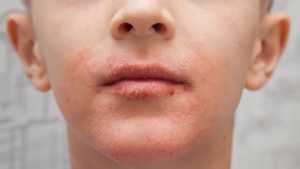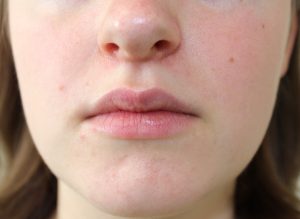Perioral dermatitis, also known as periorificial dermatitis, is a common, benign inflammatory skin condition. It is most common in young adult females aged 20 to 45 years, though it also occurs in children, typically following exposure to corticosteroids (Acevedo-Fontanez et al., 2025).
This condition usually appears as small red, raised bumps, mild scaling, or irritation around the mouth, nose, or eyes (Reichenberg, 2024; Tolaymat et al., 2025). It is commonly mistaken for other skin conditions, like acne or eczema. The most reliable treatment options include removing triggers, simplifying your skincare routine, and using medications as needed and as discussed with your pediatric healthcare provider.

What Is Perioral Dermatitis?
Perioral dermatitis presents with clusters of small papules, pustules, or pink scaly patches around the mouth, nostrils, or eyes (Tolaymat et al., 2025), which can be irritating for children.
Perioral dermatitis can be confused with:
- Irritant or allergic contact dermatitis
- Bacterial or fungal infections
It has been considered a variant of rosacea and typically responds to the same treatment therapies as rosacea. Your child must be seen by their pediatric healthcare provider or dermatologist, as it is often confused with other conditions (Acevedo-Fontanez et al., 2025).
Granulomatous Perioral Dermatitis

What Causes Perioral Dermatitis?
The exact cause remains unclear, but research consistently identifies several common triggers (Reichenberg, 2024; Tolaymat et al., 2025):
- Topical corticosteroid use (Your child may be initially responsive to steroids, though it can cause the condition to worsen, recur, or vary.)
- Nasal corticosteroids
- Fluorinated toothpaste
- Chewing gum or dental fillings
- Certain cosmetics, skincare materials, and sunscreens
- Improper CPAP therapy
- Hormonal factors
- Oral contraceptive therapy
- Infectious sources, like bacteria, yeast, or mites
- Wearing facemasks
- Confirmed or strongly suspected triggers
Corticosteroid Use
Because topical steroid use can trigger perioral dermatitis (Tolaymat et al., 2025), do not use them to treat perioral dermatitis. Nasal or inhaled corticosteroids can also cause flare-ups, especially if some of the medication remains on the skin after use. However, stopping topical steroids abruptly can cause a rebound flare. Instead, taper your topical steroid use gradually over several weeks.
Perioral Dermatitis Treatment
1. Stop Using Irritating Products
- Gradually stop topical corticosteroids on the affected area over several weeks (and know that there may be a normal rebound flare after discontinued use).
- Simplify skincare by avoiding heavy creams, scented products, or harsh cleansers.
- Cleanse with lukewarm water or a gentle, fragrance-free cleanser.
- Avoid fluorinated toothpaste.
- Avoid applying heavy cosmetics
2. Medications
Your provider might suggest a topical medication. Treatment is often effective with these medications; however, perioral dermatitis can be recurrent or persistent and may require long-term management. Medications include (Reichenberg, 2024; Tolaymat et al., 2025):
- Topical metronidazole
- Topical clindamycin
- Topical sulfur
- Topical azelaic acid
- Topical calcineurin inhibitors
- Photodynamic therapy
- Oral or topical erythromycin
- Oral or topical antibiotics
3. Use Supportive Skincare
- Simplify skincare by avoiding any extra products or materials
- Washing with warm water only or a fragrance-free, non-foaming, gentle facewash
- Using a simple, non-comedogenic, fragrance-free moisturizer for dryness
- Avoiding physical exfoliants or scrubbing
- Sun protection with mineral sunscreens (zinc oxide or titanium dioxide), which are less irritating than chemical filters
What About Natural Remedies?
Many “natural” treatments, such as apple cider vinegar, grapefruit seed extract, or aloe, are widely discussed online but lack controlled evidence to support their use in treating perioral dermatitis. Some (especially apple cider vinegar) can worsen irritation or disrupt the skin barrier.
Aloe vera may provide mild soothing for general irritation and sun damage, but it is not an established treatment and should not be applied to broken or highly sensitive skin.
The Psychological Effects of Perioral Dermatitis
Both perioral dermatitis and rosacea are linked to long-term psychological risks. These skin issues can increase depression, anxiety, and stress, and recognizing the mental health aspect of them is vital (Andrén et al., 2026). We know that these symptoms can intensify over time. If you suspect your child is exhibiting psychological distress, it is important that they get screened early and get the proactive support they need.
When to Contact Your Pediatric Healthcare Provider
- Persistent or spreading rash
- Significant discomfort, swelling, or crusting
- Rash appeared after steroid use
- You are unsure whether the rash is perioral dermatitis or another skin condition
- Your child might be experiencing psychological distress




